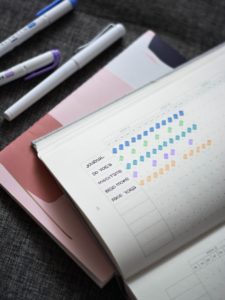I am the first one to admit that I can be very irresponsible when it comes to finances. I don’t pay attention to what’s going on my credit cards. I use my debit card as if its a magically renewing resource and I haven’t put money into my savings account in a long time. I have tons of fantasies of all the things I’d like to do that inevitably cost money but have no idea how long it would take to realistically reach these goals because I’m simply not being proactive about my finances. Instead I’m being reactive. Which basically means freaking out when I finally reach a point where I want to buy something and I can’t due to insufficient funds or every year when I do my taxes and I get to see how I’m not any further ahead financially this year then I was the year before.
Generally speaking I’m comfortable. I have a roof over my head in a nice apartment in a great city. I’m healthy (as far as I know) and can afford to eat good quality foods. I took a great vacation last year to Europe, I have extra money to spend on trainers and certifications, I have relatively low debt. But on the other hand, since Covid my monthly income has decreased drastically. I don’t own my dwelling (something that is not a priority to me right now but eventually it will be). I don’t have an emergency fund. I don’t have investments. So while I’m always comfortable nothing really improves.
But I’m ready to get out of my comfort zone and make my finances a priority. While I’m still young enough to hustle for it, and while retirement is still far enough away that I’m not too stressed about it. Trying to reach goals in a stressed state is not ideal after all.
I want 2021 to be about getting my finances in order, and finding new streams of income and making headway on my short, mid and long term financial goals once and for all. It’s time to start ADULTING! Here are some steps that can help you get a grasp on your finances so that you can stop feeling overwhelmed and instead start to feel in control by making a plan.
Step 1 — Figure out where you’re at
As with all goals you must first figure out where you are to be able to chart a course to where you would like to be. So I start with finally opening all those brown envelopes that have been piling up. For those of you who don’t live in Canada a brown envelope is usually money I owe the government or money the government owes me. And since I know they don’t owe me anything it means all of those envelopes are bad news. One was an update of the the balance on my biggest debt so that was good to know as I really haven’t been aware of the balance in over a year. Another brown envelope was a reminder for me to pay my license so I did that. Last year I waited until the 4th notice and ended up having to pay the late fee. Paying more simply because I was too irresponsible to stay on top of my bills is called “the stupid tax”. The last brown envelope was a reminder to pay a parking ticket I received last month so I paid that as well.
Next I finally looked at my credit card statement and was able to see that I’ve been paying for an amazon prime membership that I really don’t need so I cancelled that.
Step 2 — Figure out where you want to be
Next I wrote out my financial goals in short term, mid term, and long term goals. I wrote out how much money it would take to reach the goal, what date I would like to reach the goal and how much I had already put towards it with the balance remaining divided into monthly payments between now and the deadline.
For now I kept it short because before I can make any major contributions to investments and big ticket goals I first want to boost my emergency fund and pay down more debt. I’m not saying I have to have fully reached those goals before I start investing but I would like to make some headway on it first. I used the Financial Worksheet below to record my financial goals.
Step 3 — Figure out what is possible NOW
Next I filled in a budget that shows all of my expenses along with my income. I now have a clear idea of how much more I need to make monthly to reach my financial goals. I can also see where I can cut back in the discretionary spending category. I used the Budget for Your Goals Worksheet below to figure this out. If you’re expenses are generally fixed you can just fill one out and make adjustments as necessary over the course of the year, but I like to have something to track and compare to so I will make a copy and fill one out for each month, especially since as an entrepreneur I have fluctuating expenses and income.
Budget For Your Goals Worksheet
Step 4 — Keep yourself accountable
And lastly I downloaded the Wallet app and synced my bank accounts to it. I entered my financial goals from my financial worksheet as well as my budget. worksheet. I will spend the next month tracking my expenses closely so I can understand where I’m spending my money and possibly revise my budget. Making small purchases with your debit card adds up fast at the end of the month. Who knows I may have an extra $100 to put towards my goals if I cut back on buying coffees at my local café. The alerts I’ll receive through this app, of my daily spending will also be useful as a virtual accountability partner. When I get an alert telling me that I’m about to go over my monthly allowance for spending money it may make me think twice about getting that $30 mascara from M.A.C.
Step 5 — Follow up and adjust
Check in monthly with your finances to see where you are spending your money and to see if any of that spent money can be reallocated towards your financial goals. Change goals and update your budget as necessary, because doing all this is not to lock you into something that you don’t want. It’s just to make sure you feel in control of your life and your finances and that you actually have a system in place to get where you want to be no matter how long it might take. Also being able to see every month in black and white how much money you’re missing to meet your financial goals will help you find the opportunities to make up that money in other ways. Knowing you need another $100 a month is something your brain can grasp onto and then help you take action accordingly vs telling yourself you need to make “more” money, which is arbitrary, not quantifiable and easily forgettable. Wishy washy goals are less likely to be followed through on vs concrete goals. Use the same SMART approach to setting your financial goals as the rest of the goals in your life.
Let’s make 2021 the year of raising our financial ceiling and reaching our financial goals!




